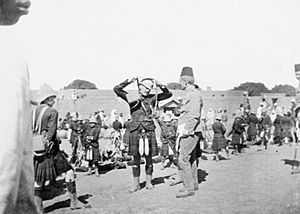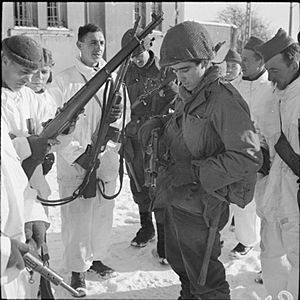Queen's Own Cameron Highlanders facts for kids
Quick facts for kids Queen's Own Cameron Highlanders |
|
|---|---|
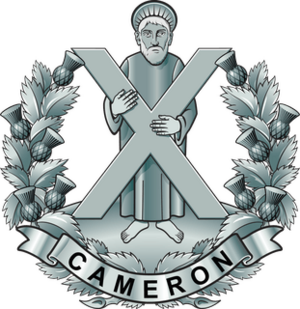
Cap Badge of the Queen's Own Cameron Highlanders
|
|
| Active | 1793–1961 |
| Country | |
| Branch | |
| Type | Infantry |
| Role | Line infantry |
| Part of | Highland Brigade |
| Garrison/HQ | Cameron Barracks, Inverness |
| Motto(s) | Pro rege et patria (For King and country) |
| March | Quick (band): The Cameron Highlanders Quick (pipes): Pibroch Domhnall Dubh Slow (band): Logie o' Buchan |
| Commanders | |
| Colonel-in-Chief | Prince Philip, Duke of Edinburgh |
| Insignia | |
| Tartan | 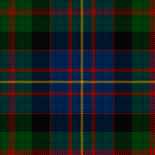 Cameron of Erracht |
| Pipers | Royal Stuart tartan |
The Queen's Own Cameron Highlanders was a famous infantry regiment of the British Army. It was first formed in 1793. This regiment was known for its brave soldiers and their distinctive tartan kilts. In 1961, it joined with the Seaforth Highlanders to create a new regiment called the Queen's Own Highlanders.
Contents
History of the Regiment
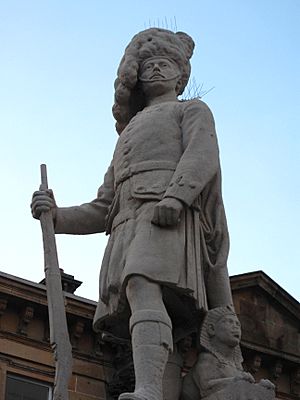
The regiment began on August 17, 1793. It was called the 79th Regiment of Foot (Cameronian Volunteers). Sir Alan Cameron of Erracht started it at Fort William. Many of the first soldiers came from Clan Cameron in Lochaber. Over time, the regiment recruited soldiers from all over the Scottish Highlands.
Early Wars with France (1793–1815)
The regiment first went to Flanders in 1794. They fought in an unsuccessful campaign during the French Revolutionary Wars. After returning to England, they were sent to the West Indies in 1795 for two years.
In 1799, the 79th Foot fought the French again. This was at the Battle of Alkmaar in Holland. In 1800, they were part of a failed attack on the Spanish coast at Ferrol.
The 79th Foot went to Egypt in 1801. They helped stop France from controlling the route to India. They fought in the Battle of Abukir and Alexandria. After these wins, the British forced the French to surrender in Cairo. Because of their bravery in Egypt, the regiment was allowed to put a sphinx symbol on their flags and badges.
In 1804, the regiment became part of the British Army. It was renamed the 79th Regiment of Foot (Cameron Highlanders). They fought in the Battle of Copenhagen in 1807.
The 79th Foot went to Portugal in 1808 for the Peninsular War. They fought in many important battles. These included the Battle of Corunna (1809), Battle of Bussaco (1810), and Battle of Fuentes de Oñoro (1811). They also took part in the Siege of Badajoz (1812) and the Battle of Salamanca (1812).
Later, they fought in the Battle of the Pyrenees (1813) and the Battle of Toulouse (1814). After Napoleon gave up power, the regiment moved to Ireland.
However, Napoleon returned from exile. So, the 79th Foot went to Belgium in May 1815. They fought in the final battles of the Napoleonic Wars. These were the Quatre Bras and Waterloo in June 1815. Out of 675 soldiers, 103 were killed and 353 were wounded. The Duke of Wellington, a famous general, specifically mentioned the 79th for their bravery at Waterloo.
From 1816 to 1880
After the Napoleonic Wars, the 79th Foot stayed in France until 1818. Then they served in the UK. They also had tours in Canada (1825–36 and 1848–51) and Gibraltar (1841–48).
In 1854, the regiment went to the Crimean War. They fought in the Battle of Alma and the Battle of Balaclava. They also took part in the long siege of Sevastopol.
After a short time back in the UK, the regiment went to India. They helped put down the Indian Rebellion. They fought in the Capture of Lucknow in 1858. They stayed in India until 1871.
Queen Victoria gave the regiment new flags in 1873. She also said they should be called the "Queen's Own." So, they became the 79th Regiment, The Queen's Own Cameron Highlanders.
From 1881 to 1914
In 1881, the 79th Foot was renamed the 1st Battalion, Queen's Own Cameron Highlanders. It became the main regiment for Inverness-shire. In 1886, their new base, Cameron Barracks, was built in Inverness. In 1897, a second regular battalion was formed.
In 1882, the 1st Battalion went to Egypt. They fought in the Anglo-Egyptian War, including the Battle of Tel el-Kebir. They also took part in the Nile Expedition to the Sudan in 1884-1885.
The 1st Battalion returned to the UK in 1887. They later went to Malta, Gibraltar, and back to Egypt in 1897. They were part of General Kitchener's army in the 1898 reconquest of the Sudan. They fought in the Battle of Atbara and the Battle of Omdurman.
In 1900, the 1st Battalion went to South Africa. They fought in the Second Boer War. After the war, they returned to the UK in 1902. The 2nd Battalion was formed in 1897. It served abroad in South Africa, China, and India until 1914.
First World War (1914–1918)
Many battalions of the Queen's Own Cameron Highlanders fought in World War I.
| Battalion | Notes | Service |
|---|---|---|
| 1st Btn | Regular Army | Fought in France |
| 2nd Btn | Regular Army | Started in India, then fought in France and Greece |
| 3rd (Militia) Btn | Militia | Served in Scotland then Ireland |
| 1/4th Btn | Territorial Army | Fought in France |
| 5th (Service) Btn | War-raised | Fought in France |
| 6th (Service) Btn | War-raised | Fought in France |
| 7th (Service) Btn | War-raised | Fought in France |

The 1st Battalion arrived in France in August 1914. They fought on the Western Front. The 2nd Battalion came from India and also served on the Western Front. Later, they moved to Salonika in Greece.
The 1/4th Battalion, part of the Territorial Force, arrived in France in February 1915. They also served on the Western Front.
Several new battalions were formed for the war. The 5th, 6th, and 7th Service Battalions all fought bravely on the Western Front. The 7th Battalion had a famous war poet named Dòmhnall Ruadh Chorùna. He wrote poems about his experiences in the trench warfare.
Between the World Wars
After World War I, the 1st Battalion went to India in 1919. They later served in the Sudan. The 2nd Battalion went to Ireland. They were involved in fighting during the Irish War of Independence. In 1923, they joined the occupation forces in Germany.
In 1935, the 2nd Battalion began a tour of duty abroad. They served in Palestine, Egypt, and India.
Second World War (1939–1945)
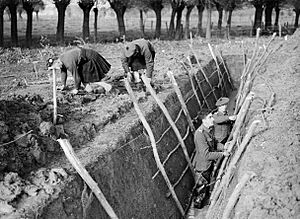
The 1st Battalion went to France in September 1939 as part of the British Expeditionary Force (BEF). They took part in the Battle of France and the Dunkirk evacuation in May 1940. After returning to England, the 1st Battalion went to Burma in 1942. They fought in many battles during the Burma Campaign, including the Battle of Kohima (1944) and the Battle of Mandalay (1945).
The 2nd Battalion was in Sudan at the start of the war. They moved to Egypt and Libya. They fought in Operation Battleaxe. Sadly, they were captured when Tobruk fell in June 1942. The battalion was reformed in the UK. They were sent to Italy in 1944 and later served in Greece.
The 4th Battalion also went to France in 1939. However, they had to surrender at Saint-Valery-en-Caux in June 1940. The 4th Battalion was reformed in the UK. A small group was also sent to Bermuda to help with its defense.
The 5th Battalion fought in the Second Battle of El Alamein in October 1942. They also took part in the Allied invasion of Sicily in July 1943. This battalion was involved in the Normandy landings in June 1944. They then fought in the Battle for Caen, the Battle of the Falaise Gap, and the Battle of the Bulge.
The 7th Battalion was later changed into the 5th (Scottish) Parachute Battalion. Soldiers who were not suitable for parachute duties were moved to other units.
An Australian army unit, the 61st Battalion, was allowed to use the name "Queensland Cameron Highlanders" in 1939. This battalion fought in the Battle of Milne Bay (1942) and the Bougainville Campaign (1944-1945).
After the Second World War
After the war, the 1st Battalion served in Japan. Then they went to Malaya in 1947 for security duties. In 1948, the 2nd Battalion was put on hold. The 1st Battalion later served in Libya, the Suez Canal Zone, Scotland, Austria, and Germany.
In 1955, the regiment was part of the United Nations forces in Korea after the Korean War. They also served in Aden in 1956.
In 1957, the British Army decided to reduce the number of infantry battalions. So, the Queen's Own Cameron Highlanders joined with the Seaforth Highlanders on February 7, 1961. They formed a new regiment called the Queen's Own Highlanders.
Battle Honours
Battle honours are special awards given to military units for their bravery and success in battles. The Queen's Own Cameron Highlanders earned many battle honours throughout their history:
- Early Wars: Egmont-Op-Zee, Egypt, Corunna, Busaco, Fuentes D'Onor, Salamanca, Pyrenees, Nivelle, Nive, Toulouse, Peninsula, Waterloo, Alma, Sevastopol, Lucknow, Egypt 1882, Tel-El-Kebir, Nile 1884–5, Khartoum, Atbara, South Africa, 1900–02
- The Great War: Retreat from Mons, Marne 1914 '18, Aisne 1914, Ypres 1914 '15 '17 '18, Langemarck 1914, Gheluvelt, Nonne Bosschen, Givenchy 1914, Neuve Chapelle, Hill 60, Gravenstafel, St. Julien, Frezenberg, Bellewaarde, Aubers, Festubert 1915, Loos, Somme 1916 '18, Albert 1916, Bazentin, Delville Wood, Pozières, Flers-Courcelette, Morval, Le Transloy, Ancre Heights, Arras 1917 '18, Scarpe 1917, Arleux, Pilckem, Menin Road, Polygon Wood, Poelcappelle, Passchendaele, St. Quentin, Bapaume 1918, Lys, Estaires, Messines 1918, Kemmel, Béthune, Soissonnais-Ourcq, Drocourt-Quéant, Hindenburg Line, Épéhy, St. Quentin Canal, Courtrai, Selle, Sambre, France and Flanders 1914–18, Struma, Macedonia 1915-18
- The Second World War: Defence of Escaut, St. Omer-La Bassée, Somme 1940, St. Valery-en-Caux, Falaise, Falaise Road, La Vie Crossing, Le Havre, Lower Maas, Venlo Pocket, Rhineland, Reichswald, Goch, Rhine, North-West Europe 1940 '44-45, Agordat, Keren, Abyssinia 1941, Sidi Barrani, Tobruk 1941 '42, Gubi II, Carmusa, Gazala, El Alamein, Mareth, Wadi Zigzaou, Akarit, Djebel Roumana, North Africa 1940–43, Francofonte, Adrano, Sferro Hills, Sicily 1943, Cassino, Poggio del Grillo, Gothic Line, Tavoleto, Coriano, Pian di Castello, Monte Reggiano, Rimini Line, San Marino, Italy 1944, Kohima, Relief of Kohima, Naga Village, Aradura, Shwebo, Mandalay, Ava, Irrawaddy, Mt. Popa, Burma 1944-45
Victoria Cross Recipients
The Victoria Cross is the highest award for bravery in the British military. The following soldiers from the Queen's Own Cameron Highlanders received this award:
- Donald Farmer (Second Boer War)
- Angus Douglas-Hamilton (First World War)
- James Dalgleish Pollock (First World War)
- Ross Tollerton (First World War)
Colonels-in-Chief
- 1902–1936: F.M. King George V
- 1936–1953: F.M. King George VI
- 1953–1961: F.M. The Prince Philip, Duke of Edinburgh, KG, KT, OM, GBE, AC, QSO
Affiliated Regiments
The Queen's Own Cameron Highlanders had connections with other regiments around the world:
Canada
Australia
- 16th Battalion (The Cameron Highlanders of Western Australia)
- 37/39 Battalion (The Henty Regiment)
- 52nd Battalion (The Gippsland Regiment)
New Zealand
- Otago and Southland Regiment
Auxiliary Territorial Service
- The Inverness unit of the Auxiliary Territorial Service in World War II wore kilts of the regiment's Cameron of Erracht tartan.
See also



